
Common Snake Species in Manchester
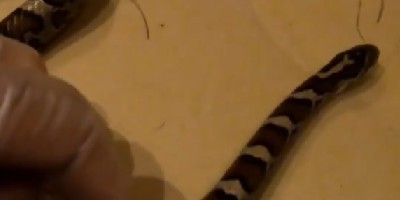 Milksnake:
The eastern milksnake (Lampropeltis triangulum triangulum) is a non-venomous type of kingsnake that is fairly large, usually growing over 24 inches (60 cm) and all the way up to 50 inches (130 cm). It has a bold color pattern that makes it easy to spot - an alternation of red, yellow, black, or white blotches. This also means it often gets mistaken for other snake species. While the milksnake is fairly slender-bodied, it can grow bulky in old age. It mostly prefers forested, rocky areas, and feeds on slugs, snails, and earthworms.
Milksnake:
The eastern milksnake (Lampropeltis triangulum triangulum) is a non-venomous type of kingsnake that is fairly large, usually growing over 24 inches (60 cm) and all the way up to 50 inches (130 cm). It has a bold color pattern that makes it easy to spot - an alternation of red, yellow, black, or white blotches. This also means it often gets mistaken for other snake species. While the milksnake is fairly slender-bodied, it can grow bulky in old age. It mostly prefers forested, rocky areas, and feeds on slugs, snails, and earthworms.
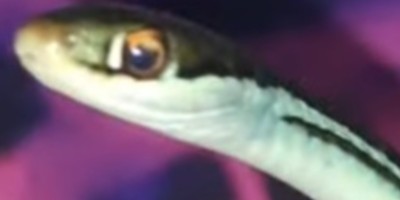 Ribbon Snake:
The ribbon snake (Thamnophis sauritus) is a fairly common species of garter snake. It’s a very slender and fairly short serpent, usually not exceeding 30 inches (90 cm) in length. It is thus named because of the three yellow/green stripes that run down its body, giving it a festive appearance. The ribbon snake is an aquatic serpent that loves hanging out near creeks, streams, lakes, and so on. Appropriately, they prey mostly on aquatic creatures (newts, fish, salamanders, etc.).
Ribbon Snake:
The ribbon snake (Thamnophis sauritus) is a fairly common species of garter snake. It’s a very slender and fairly short serpent, usually not exceeding 30 inches (90 cm) in length. It is thus named because of the three yellow/green stripes that run down its body, giving it a festive appearance. The ribbon snake is an aquatic serpent that loves hanging out near creeks, streams, lakes, and so on. Appropriately, they prey mostly on aquatic creatures (newts, fish, salamanders, etc.).
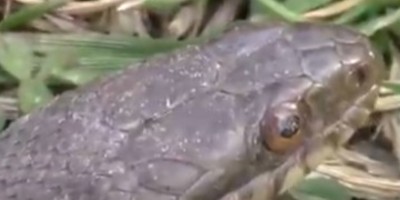 Northern Watersnake:
The northern watersnake (Nerodia sipedon sipedon) is quite often mistaken for the common watersnake (Nerodia sipedon). It is a large, non-venomous snake that, as its name suggests, prefers to spend its time near water. The northern watersnake usually grows up to 4.5 feet (135 cm) in length, although even larger specimens have been noted. Its body is bulky and it’s usually found near ponds, swamps, etc. as most water snakes are. It is a good climber and can often be found hanging off branches near water. Its base color varies, from brown to cream, to red and black, and its body is speckled with dark crossbands and blotches.
Northern Watersnake:
The northern watersnake (Nerodia sipedon sipedon) is quite often mistaken for the common watersnake (Nerodia sipedon). It is a large, non-venomous snake that, as its name suggests, prefers to spend its time near water. The northern watersnake usually grows up to 4.5 feet (135 cm) in length, although even larger specimens have been noted. Its body is bulky and it’s usually found near ponds, swamps, etc. as most water snakes are. It is a good climber and can often be found hanging off branches near water. Its base color varies, from brown to cream, to red and black, and its body is speckled with dark crossbands and blotches.
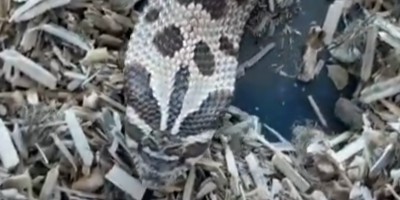 Eastern Hognose Snake:
The eastern hognose snake (Heterodon platirhinos) is an endangered species, who, although venomous, is not classified as such, since it doesn’t pose a threat to humans. It is a fairly large snake (roughly 28-30 inches, or just over 70 cm), and has a thick body. It has an upturned snout (used for digging) and its color pattern varies broadly from red, yellow, green, to brown and black. They can also have crossbands or be patternless, making them difficult to identify. The eastern hognose lives near sandy areas, open fields, or pine forests, and injects its prey (mainly amphibians) with venom.
Eastern Hognose Snake:
The eastern hognose snake (Heterodon platirhinos) is an endangered species, who, although venomous, is not classified as such, since it doesn’t pose a threat to humans. It is a fairly large snake (roughly 28-30 inches, or just over 70 cm), and has a thick body. It has an upturned snout (used for digging) and its color pattern varies broadly from red, yellow, green, to brown and black. They can also have crossbands or be patternless, making them difficult to identify. The eastern hognose lives near sandy areas, open fields, or pine forests, and injects its prey (mainly amphibians) with venom.
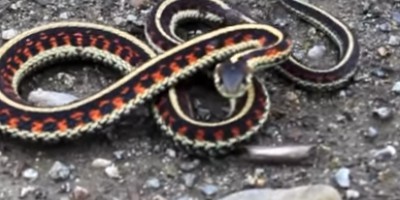 Garter Snake:
The garter snake (Thamnophis sirtalis) is a common type of non-venomous snake. It’s a small serpent, often growing to 26 inches (roughly 60 cm). It’s a highly adaptable snake, and as such, can live near water, but also in forests, open fields, and even in the back lawn. It has 2-3 light yellow stripes running down its body and may also have dark spots. Similarly to the eastern hognose snake, it uses venom (neurotoxin) to stabilize its prey but is not considered dangerous to humans, because of the very small amounts of venom released.
Garter Snake:
The garter snake (Thamnophis sirtalis) is a common type of non-venomous snake. It’s a small serpent, often growing to 26 inches (roughly 60 cm). It’s a highly adaptable snake, and as such, can live near water, but also in forests, open fields, and even in the back lawn. It has 2-3 light yellow stripes running down its body and may also have dark spots. Similarly to the eastern hognose snake, it uses venom (neurotoxin) to stabilize its prey but is not considered dangerous to humans, because of the very small amounts of venom released.